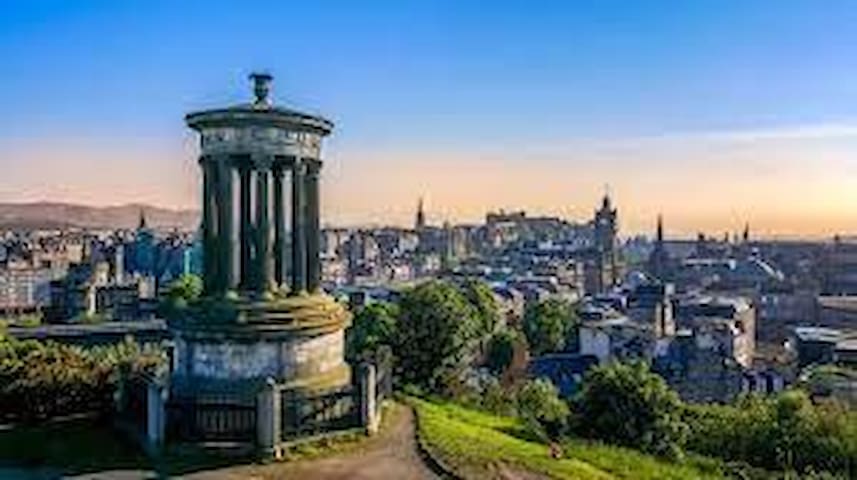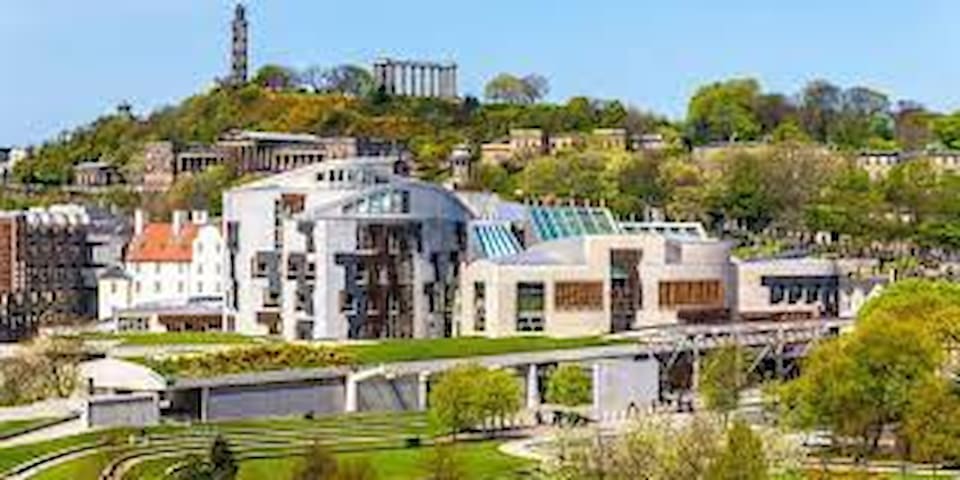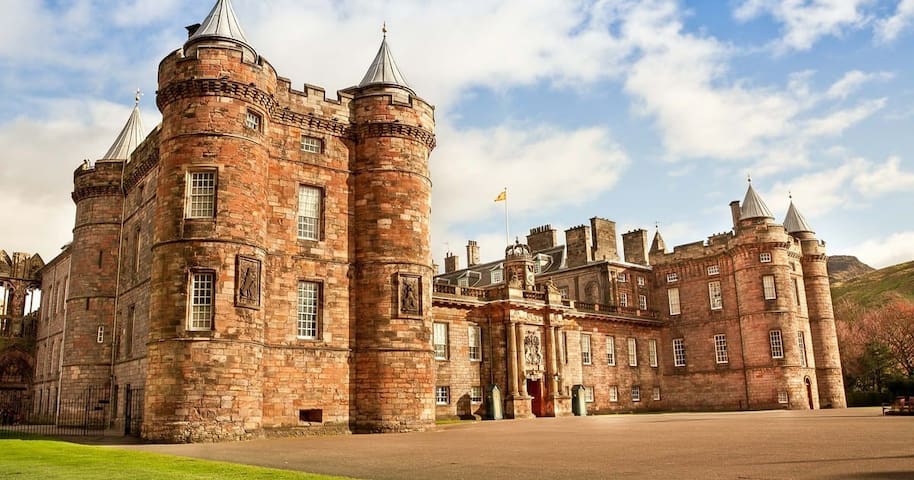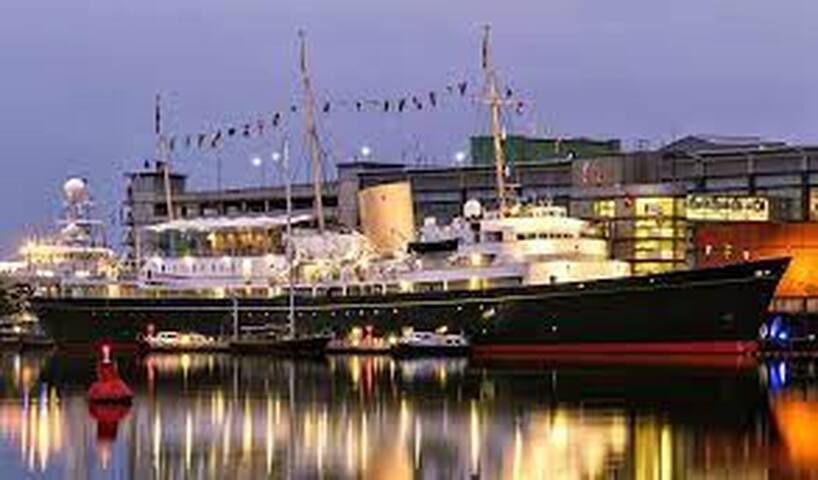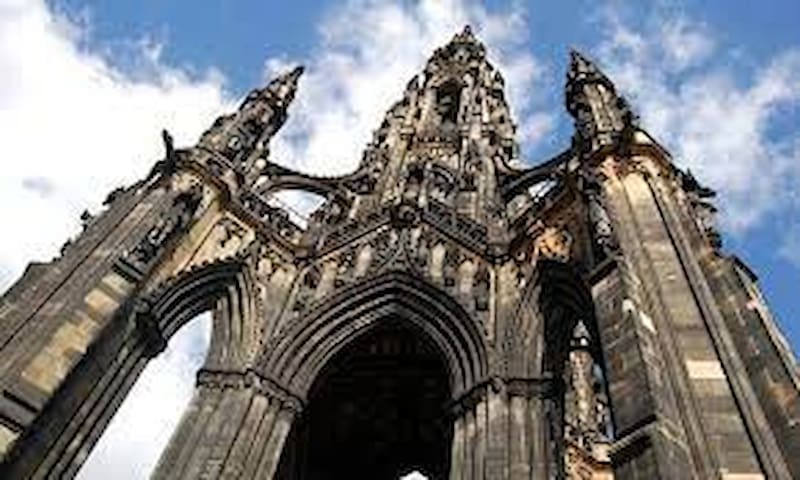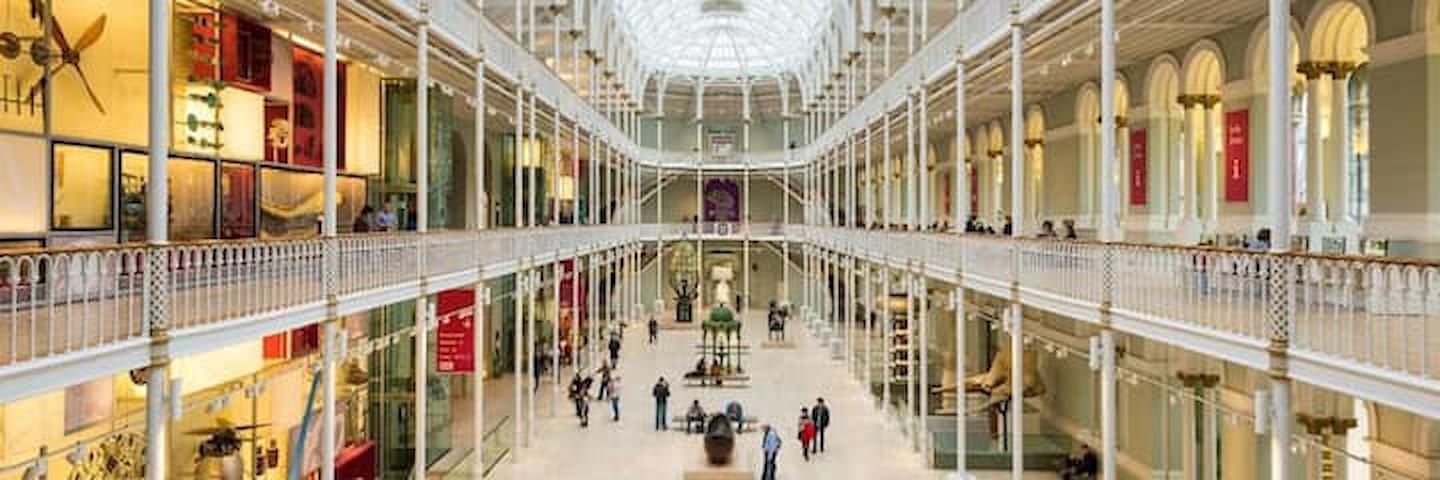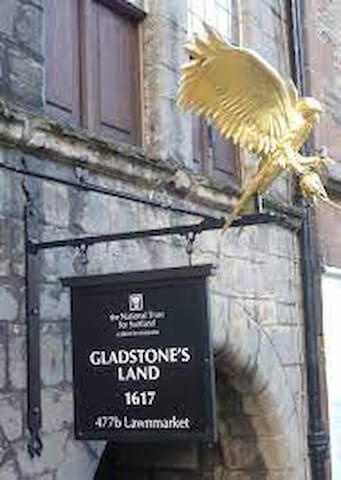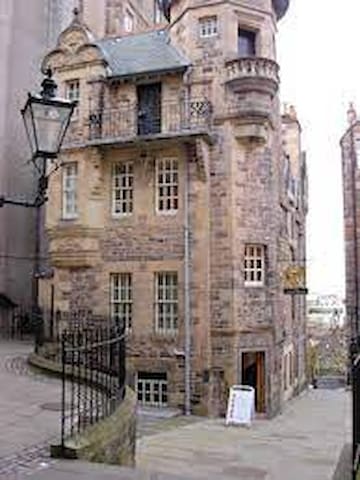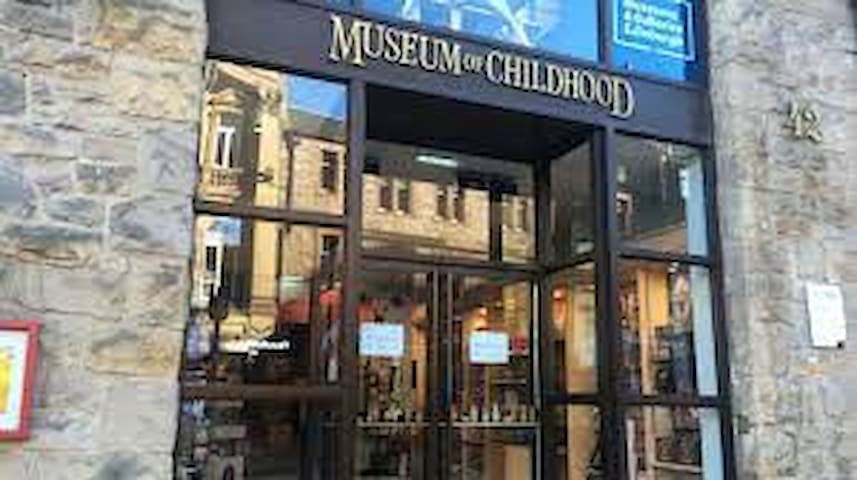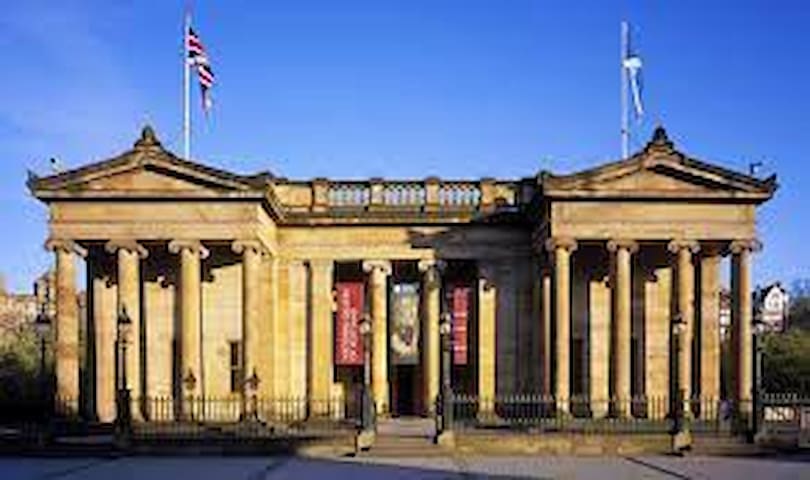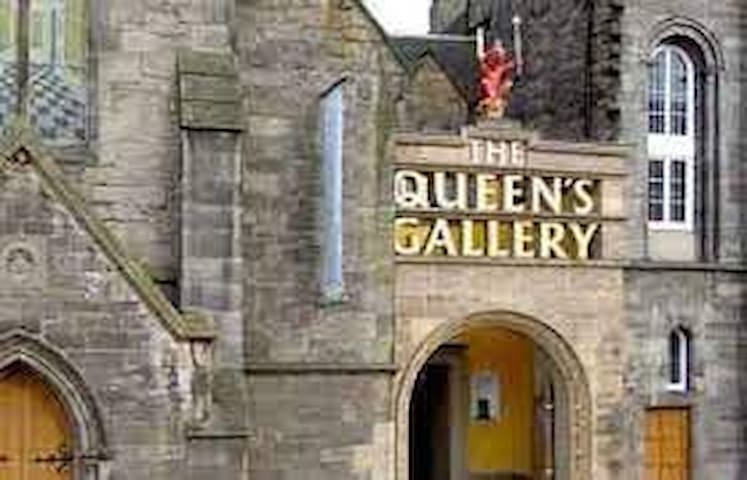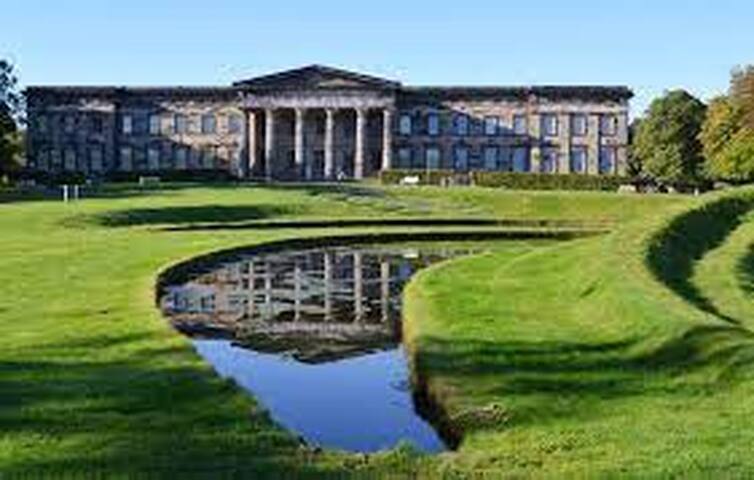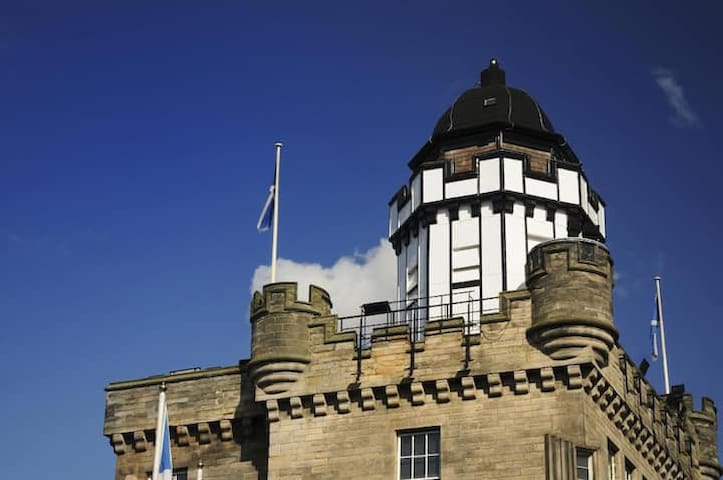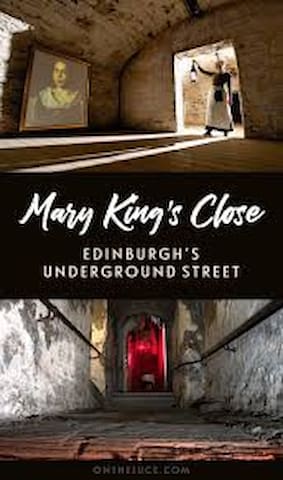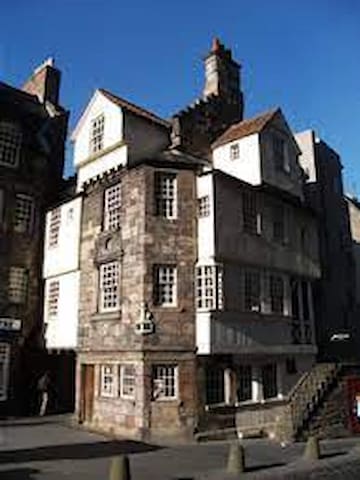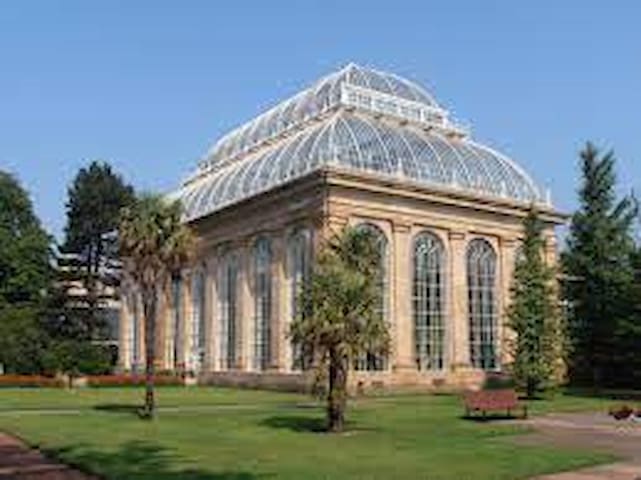The Neighbourhood
There's no better introduction to Edinburgh — the historical, cultural, and political capital of Scotland — than a walk straight down the spine of the old town. Stretching from a hill-topping castle to a Queen's palace, this ramble is appropriately called the Royal Mile; it's one of Europe's best sightseeing walks.
Begin your stroll from the top of the Royal Mile, where Edinburgh was born and where a castle now stands. Over the centuries, this mighty fortress was home to many of Scotland's kings and queens. Today it's well worth touring to see the old buildings, stunning views, and crown jewels.
As Edinburgh grew, it spilled downhill along the sloping ridge that became the Royal Mile. Back in the 1600s, this was the city's main street, bustling with breweries, printing presses, and banks. With tens of thousands of citizens squeezed into the narrow confines of the old town, there was nowhere to go but up. So builders lined the street with multistory residences called tenements — some 10 stories and higher. Stop by at Gladstone's Land, a rare surviving original tenement that was acquired by a wealthy merchant in 1617. The costumed docents and an almost-lived-in, furnished five-room interior helps you picture those days gone by.
Though much of the Royal Mile is now a touristy mall filled with tartans, shortbread, and Scottish kitsch, it's still packed with history. Explore back alleys and side lanes, it's easy to imagine Edinburgh in the 17th and 18th centuries, when visitors scurried through these alleyways, buying and selling goods and popping into taverns.
Everywhere you turn, the Royal Mile is littered with symbols of Scottish pride — from a statue of philosopher David Hume, one of the towering figures of the Scottish Enlightenment of the mid-1700s, to its very own Church of Scotland, embodied by St. Giles' Cathedral; filled with monuments, plaques, and stained-glass windows dedicated to great Scots and historical moments, St. Giles' serves as a kind of Scottish Westminster Abbey.
St. Giles' is also the home church of John Knox, whose fiery sermons helped turn once-Catholic Edinburgh into a bastion of Protestantism. Knox's influence was huge - his insistence that every person should be able to read the word of God first-hand helped give Scotland an educational system 300 years ahead of the rest of Europe. A dramatic stained-glass window shows the commotion that surrounded Knox when he preached. With his hand on the holy book, Knox seems to conduct divine electricity to the Scottish faithful packing the church.
Just down the road from St. Giles' is the John Knox House, long considered to have been Knox's home (though many historians now doubt he ever lived here). Regardless, the place has good information on Knox and his intellectual sparring partner, Mary Queen of Scots, featuring atmospheric rooms and period furniture. Attached to the John Knox House is the Scottish Storytelling Centre, where locals with the gift of gab perform regularly.
A little farther down the street is another enjoyable stop: Cadenhead's Whisky Shop. Whisky is high on the experience list of most visitors to Scotland, and distillery tours abound in the Highlands and Islands. But right in the middle of the city, a visit to a fine whisky shop like Cadenhead's offers connoisseurs a chance to buy a small bottle filled directly from the cask of their choice. Founded in 1842, Cadenhead's prides itself on bottling pure whisky without watering it down or adding cosmetic coloring.
Two worthwhile (and free) museums are The People's Story Museum, which traces the working and social lives of ordinary Edinburghers through the 18th, 19th, and 20th centuries, and the Museum of Edinburgh, another house full of old stuff, offers an interesting look at early Edinburgh history.
Just across the street is the 1688 Canongate Kirk, where the Queen and her family worship whenever they are in town. Step inside and take in the lofty blue and red interior; royal money is behind the church's excellent renovation.
Finally, after strolling past centuries of history, modern times come into view: the Scottish Parliament building. After 300 years of being ruled from London, the Scots regained their own parliament in 1999, and a few years later built this striking, eco-friendly home for it. This soaring building mixes wild angles, lots of light, bold windows, oak, and local stone into a startling complex that seems to be surging right out of the rock of Arthur's Seat, the craggy summit just beyond the base of the Royal Mile. Visitors are welcome in the public parts of the building, including a small exhibit on the parliament's history and function, and a viewing gallery overlooking the impressive Debating Chambers.
Last stop is the Palace of Holyroodhouse, one of Queen Elizabeth's official residences and the home of Scottish royalty, including James IV and Mary Queen of Scots. The Scottish monarchs also kept a home at the top end of the Mile, but they preferred the cushier Holyroodhouse to the blustery castle on the rock.
There is no doubt, you are sure to soak up plenty of Scottish history on your walk from castle to palace!
8 Einheimische empfehlen
High Street
High StreetThere's no better introduction to Edinburgh — the historical, cultural, and political capital of Scotland — than a walk straight down the spine of the old town. Stretching from a hill-topping castle to a Queen's palace, this ramble is appropriately called the Royal Mile; it's one of Europe's best sightseeing walks.
Begin your stroll from the top of the Royal Mile, where Edinburgh was born and where a castle now stands. Over the centuries, this mighty fortress was home to many of Scotland's kings and queens. Today it's well worth touring to see the old buildings, stunning views, and crown jewels.
As Edinburgh grew, it spilled downhill along the sloping ridge that became the Royal Mile. Back in the 1600s, this was the city's main street, bustling with breweries, printing presses, and banks. With tens of thousands of citizens squeezed into the narrow confines of the old town, there was nowhere to go but up. So builders lined the street with multistory residences called tenements — some 10 stories and higher. Stop by at Gladstone's Land, a rare surviving original tenement that was acquired by a wealthy merchant in 1617. The costumed docents and an almost-lived-in, furnished five-room interior helps you picture those days gone by.
Though much of the Royal Mile is now a touristy mall filled with tartans, shortbread, and Scottish kitsch, it's still packed with history. Explore back alleys and side lanes, it's easy to imagine Edinburgh in the 17th and 18th centuries, when visitors scurried through these alleyways, buying and selling goods and popping into taverns.
Everywhere you turn, the Royal Mile is littered with symbols of Scottish pride — from a statue of philosopher David Hume, one of the towering figures of the Scottish Enlightenment of the mid-1700s, to its very own Church of Scotland, embodied by St. Giles' Cathedral; filled with monuments, plaques, and stained-glass windows dedicated to great Scots and historical moments, St. Giles' serves as a kind of Scottish Westminster Abbey.
St. Giles' is also the home church of John Knox, whose fiery sermons helped turn once-Catholic Edinburgh into a bastion of Protestantism. Knox's influence was huge - his insistence that every person should be able to read the word of God first-hand helped give Scotland an educational system 300 years ahead of the rest of Europe. A dramatic stained-glass window shows the commotion that surrounded Knox when he preached. With his hand on the holy book, Knox seems to conduct divine electricity to the Scottish faithful packing the church.
Just down the road from St. Giles' is the John Knox House, long considered to have been Knox's home (though many historians now doubt he ever lived here). Regardless, the place has good information on Knox and his intellectual sparring partner, Mary Queen of Scots, featuring atmospheric rooms and period furniture. Attached to the John Knox House is the Scottish Storytelling Centre, where locals with the gift of gab perform regularly.
A little farther down the street is another enjoyable stop: Cadenhead's Whisky Shop. Whisky is high on the experience list of most visitors to Scotland, and distillery tours abound in the Highlands and Islands. But right in the middle of the city, a visit to a fine whisky shop like Cadenhead's offers connoisseurs a chance to buy a small bottle filled directly from the cask of their choice. Founded in 1842, Cadenhead's prides itself on bottling pure whisky without watering it down or adding cosmetic coloring.
Two worthwhile (and free) museums are The People's Story Museum, which traces the working and social lives of ordinary Edinburghers through the 18th, 19th, and 20th centuries, and the Museum of Edinburgh, another house full of old stuff, offers an interesting look at early Edinburgh history.
Just across the street is the 1688 Canongate Kirk, where the Queen and her family worship whenever they are in town. Step inside and take in the lofty blue and red interior; royal money is behind the church's excellent renovation.
Finally, after strolling past centuries of history, modern times come into view: the Scottish Parliament building. After 300 years of being ruled from London, the Scots regained their own parliament in 1999, and a few years later built this striking, eco-friendly home for it. This soaring building mixes wild angles, lots of light, bold windows, oak, and local stone into a startling complex that seems to be surging right out of the rock of Arthur's Seat, the craggy summit just beyond the base of the Royal Mile. Visitors are welcome in the public parts of the building, including a small exhibit on the parliament's history and function, and a viewing gallery overlooking the impressive Debating Chambers.
Last stop is the Palace of Holyroodhouse, one of Queen Elizabeth's official residences and the home of Scottish royalty, including James IV and Mary Queen of Scots. The Scottish monarchs also kept a home at the top end of the Mile, but they preferred the cushier Holyroodhouse to the blustery castle on the rock.
There is no doubt, you are sure to soak up plenty of Scottish history on your walk from castle to palace!
City information
Edinburgh is the historical, cultural, and political capital of Scotland. For nearly a thousand years, Scotland's kings, parliaments, writers, thinkers, and bankers have called Edinburgh home.
Today, it remains Scotland's most sophisticated and entertaining city. It's a place of stunning vistas — nestled among craggy bluffs and studded with a prickly skyline of spires, towers, domes, and steeples.
The city hums with life. Historic, monumental, fun, and well organised, Edinburgh is a tourist's delight.
285 Einheimische empfehlen
Edinburgh
Edinburgh is the historical, cultural, and political capital of Scotland. For nearly a thousand years, Scotland's kings, parliaments, writers, thinkers, and bankers have called Edinburgh home.
Today, it remains Scotland's most sophisticated and entertaining city. It's a place of stunning vistas — nestled among craggy bluffs and studded with a prickly skyline of spires, towers, domes, and steeples.
The city hums with life. Historic, monumental, fun, and well organised, Edinburgh is a tourist's delight.
Sightseeing
Scotland's most famous landmark, Edinburgh Castle is one of Britain's most visited tourist attractions. Highlights of a visit include hearing the famous One O'clock Salute from Half Moon Battery (cannon fire commemorates the tradition of helping ships synchronise their clocks), the impressive Scottish National War Memorial and National War Museum, and the stunning collection of Crown Jewels housed in the Royal Palace.
Another notable feature is the Stone of Destiny (aka, the Stone of Scone), famously stolen by Edward I and placed under the English throne in London - only returned to Scotland 700 years later in 1996. If you want to save time, consider purchasing a Skip the Line: Edinburgh Castle Entrance Ticket, so you can spend more time touring the castle instead of waiting in the long lines.
1961 Einheimische empfehlen
Burg Edinburgh Castle
CastlehillScotland's most famous landmark, Edinburgh Castle is one of Britain's most visited tourist attractions. Highlights of a visit include hearing the famous One O'clock Salute from Half Moon Battery (cannon fire commemorates the tradition of helping ships synchronise their clocks), the impressive Scottish National War Memorial and National War Museum, and the stunning collection of Crown Jewels housed in the Royal Palace.
Another notable feature is the Stone of Destiny (aka, the Stone of Scone), famously stolen by Edward I and placed under the English throne in London - only returned to Scotland 700 years later in 1996. If you want to save time, consider purchasing a Skip the Line: Edinburgh Castle Entrance Ticket, so you can spend more time touring the castle instead of waiting in the long lines.
Consecrated in 1243, St. Giles Cathedral — also known as the High Kirk of Edinburgh — is Edinburgh's principal church. It's also one of the city's most popular places to visit, attracting upwards of a million visitors each year.
The current structure was built in the 1300s and is notable for its impressive 161-foot-tall central tower with its eight arched buttresses. These form a huge crown (the Crown Steeple), which has become a favourite backdrop for photos and selfies. Interior highlights include memorials to the dead of WWI; lovely stained-glass windows; and a statue of John Knox, leader of the Protestant Reformation (his former home, 45 High Street, is close by and contains a museum).
The Thistle Chapel is also worth checking out and is best known for its oak carvings; heraldic emblems; and seals of the "Knights of the Thistle," Scotland's oldest order of knights. Sir Robert Lorimer designed the chapel in 1911, and it's a superb example of the modern Gothic style. Fun things to do while visiting the cathedral include joining a rooftop tour or enjoying an afternoon choir concert.
152 Einheimische empfehlen
St Giles’ Cathedral
High StreetConsecrated in 1243, St. Giles Cathedral — also known as the High Kirk of Edinburgh — is Edinburgh's principal church. It's also one of the city's most popular places to visit, attracting upwards of a million visitors each year.
The current structure was built in the 1300s and is notable for its impressive 161-foot-tall central tower with its eight arched buttresses. These form a huge crown (the Crown Steeple), which has become a favourite backdrop for photos and selfies. Interior highlights include memorials to the dead of WWI; lovely stained-glass windows; and a statue of John Knox, leader of the Protestant Reformation (his former home, 45 High Street, is close by and contains a museum).
The Thistle Chapel is also worth checking out and is best known for its oak carvings; heraldic emblems; and seals of the "Knights of the Thistle," Scotland's oldest order of knights. Sir Robert Lorimer designed the chapel in 1911, and it's a superb example of the modern Gothic style. Fun things to do while visiting the cathedral include joining a rooftop tour or enjoying an afternoon choir concert.
Scotland's Parliament sits at the foot of Edinburgh's famous Royal Mile in front of the spectacular Holyrood Park and Salisbury Crags. Constructed from a mixture of steel, oak, and granite, the complex building was hailed on opening as one of the most innovative designs in Britain today.
Drawing inspiration from the surrounding landscape, the flower paintings by Charles Rennie Mackintosh and the upturned boats on the seashore, Enric Miralles, one of the world's premier architects, developed a design that he said was a building "growing out of the land".
Open to the public. Guided tours.
314 Einheimische empfehlen
Scottish Parliament Building
Scotland's Parliament sits at the foot of Edinburgh's famous Royal Mile in front of the spectacular Holyrood Park and Salisbury Crags. Constructed from a mixture of steel, oak, and granite, the complex building was hailed on opening as one of the most innovative designs in Britain today.
Drawing inspiration from the surrounding landscape, the flower paintings by Charles Rennie Mackintosh and the upturned boats on the seashore, Enric Miralles, one of the world's premier architects, developed a design that he said was a building "growing out of the land".
Open to the public. Guided tours.
The Palace of Holyroodhouse — usually simply referred to as Holyrood Palace — is the Queen's official Edinburgh residence and has frequently been at the centre of Scottish history. Built in 1678, it was where James II and James IV were each married, where James V and Charles I were crowned, and where "Bonnie Prince Charlie" held court in 1745.
When the Queen is away (which is typically 51 weeks of the year, as she's only here for "Royal Week" each summer), public access is permitted to the stunning Historic Apartments (former home of Mary Queen of Scots) and the State Apartments, famous for their fine furnishings, tapestries, and plasterwork.
The Great Gallery displays portraits of Scottish kings, both legendary and real. The Queen's Gallery, opened in 2002 as part of the Golden Jubilee celebrations, hosts changing exhibitions from the Royal Collection. The neighboring 12th-century Holyrood Abbey was founded by King David I.
If you've got time, linger a little longer in the charming café and enjoy a proper afternoon tea. Guided tours are available.
462 Einheimische empfehlen
Holyrood Palace
CanongateThe Palace of Holyroodhouse — usually simply referred to as Holyrood Palace — is the Queen's official Edinburgh residence and has frequently been at the centre of Scottish history. Built in 1678, it was where James II and James IV were each married, where James V and Charles I were crowned, and where "Bonnie Prince Charlie" held court in 1745.
When the Queen is away (which is typically 51 weeks of the year, as she's only here for "Royal Week" each summer), public access is permitted to the stunning Historic Apartments (former home of Mary Queen of Scots) and the State Apartments, famous for their fine furnishings, tapestries, and plasterwork.
The Great Gallery displays portraits of Scottish kings, both legendary and real. The Queen's Gallery, opened in 2002 as part of the Golden Jubilee celebrations, hosts changing exhibitions from the Royal Collection. The neighboring 12th-century Holyrood Abbey was founded by King David I.
If you've got time, linger a little longer in the charming café and enjoy a proper afternoon tea. Guided tours are available.
The Royal Yacht Britannia is one of Britain's most popular attractions associated with the monarchy. Over the years, the Queen has welcomed heads of state and famous people from around the world to this luxurious vessel. After more than 40 years serving the Royal Family, the 60-year-old yacht was sent to Leith, Edinburgh's port area, as the centerpiece of the Britannia Visitor Centre.
Once aboard, you'll learn about the history of this and other royal yachts as you explore the ship's five main decks. Highlights include the Royal Apartments and bedrooms; the lovely sun lounge; and the onboard Royal Deck Tea Room, where you can stop for tea and cakes.
For those wanting to spoil themselves with a luxury getaway, consider a stay aboard the former lighthouse ship, the Fingal, docked adjacent to the royal yacht.
630 Einheimische empfehlen
Britannia
Ocean DriveThe Royal Yacht Britannia is one of Britain's most popular attractions associated with the monarchy. Over the years, the Queen has welcomed heads of state and famous people from around the world to this luxurious vessel. After more than 40 years serving the Royal Family, the 60-year-old yacht was sent to Leith, Edinburgh's port area, as the centerpiece of the Britannia Visitor Centre.
Once aboard, you'll learn about the history of this and other royal yachts as you explore the ship's five main decks. Highlights include the Royal Apartments and bedrooms; the lovely sun lounge; and the onboard Royal Deck Tea Room, where you can stop for tea and cakes.
For those wanting to spoil themselves with a luxury getaway, consider a stay aboard the former lighthouse ship, the Fingal, docked adjacent to the royal yacht.
The story of the monument, and much more, is told within the monument’s Museum Room on the first floor. Visitors can discover more about Scott himself, his tumultuous life, his legacy on international literature, as well as the memorial built in his honour. Sound points enable visitors to listen to extracts from his writings.
The Museum Room is also the best place to view four magnificent stained-glass windows, designed by leading 19th century Scottish artist David Roberts and made by James Ballantine. They feature two saints, Andrew and Giles, as well as the coat of arms of the City of Edinburgh and the coat of arms of Scotland. The room also provides a welcome pause before embarking on the climb to 3rd viewing platform.
Sitting proudly at the base of the monument is Sir Walter himself, carved in Carrara marble by Sir John Steell. This monumental statue, fashioned from a single piece of marble weighing 30 tons, took the sculptor six years to complete. It features Scott and his beloved hound Maida.
302 Einheimische empfehlen
Scott Monument
The story of the monument, and much more, is told within the monument’s Museum Room on the first floor. Visitors can discover more about Scott himself, his tumultuous life, his legacy on international literature, as well as the memorial built in his honour. Sound points enable visitors to listen to extracts from his writings.
The Museum Room is also the best place to view four magnificent stained-glass windows, designed by leading 19th century Scottish artist David Roberts and made by James Ballantine. They feature two saints, Andrew and Giles, as well as the coat of arms of the City of Edinburgh and the coat of arms of Scotland. The room also provides a welcome pause before embarking on the climb to 3rd viewing platform.
Sitting proudly at the base of the monument is Sir Walter himself, carved in Carrara marble by Sir John Steell. This monumental statue, fashioned from a single piece of marble weighing 30 tons, took the sculptor six years to complete. It features Scott and his beloved hound Maida.
Museums
Since opening in 2011, the National Museum has become one of Scotland's most popular attractions, and one of the best things to do for free in Edinburgh. Welcoming over two million visitors each year, it incorporates collections from a number of Edinburgh's older museums, with highlights including national archaeological collections; medieval artifacts; and displays focusing on natural history, geology, art, science, and technology.
In its 16 galleries, containing more than 8,000 artifacts, are Dolly the sheep — the world's first cloned mammal — as well as some of Elton John's more elaborate stage costumes. Traditional museum displays also include material from Ancient Egypt and the infamous Maiden, an early form of guillotine. There's plenty to see and do here, so expect to spend at least three or four hours exploring. Guided tours are available, and two restaurants are located on-site.
The Museum of Edinburgh is also worth a look, and features fascinating displays related to the city's long and rich history. So, too, is the Surgeons' Hall Museum. Set in the Royal College of Surgeons, this fascinating museum features collections relating to medicine and surgical procedures.
1378 Einheimische empfehlen
National Museum of Scotland
Since opening in 2011, the National Museum has become one of Scotland's most popular attractions, and one of the best things to do for free in Edinburgh. Welcoming over two million visitors each year, it incorporates collections from a number of Edinburgh's older museums, with highlights including national archaeological collections; medieval artifacts; and displays focusing on natural history, geology, art, science, and technology.
In its 16 galleries, containing more than 8,000 artifacts, are Dolly the sheep — the world's first cloned mammal — as well as some of Elton John's more elaborate stage costumes. Traditional museum displays also include material from Ancient Egypt and the infamous Maiden, an early form of guillotine. There's plenty to see and do here, so expect to spend at least three or four hours exploring. Guided tours are available, and two restaurants are located on-site.
The Museum of Edinburgh is also worth a look, and features fascinating displays related to the city's long and rich history. So, too, is the Surgeons' Hall Museum. Set in the Royal College of Surgeons, this fascinating museum features collections relating to medicine and surgical procedures.
Just a stone’s throw from the castle, this 500-year-old building is a towering testament to tenement life in Edinburgh’s Old Town. It was once owned by merchant Thomas Gladstone, who extended and remodelled the building to create opulently decorated apartments. Gladstone attracted wealthy tenants including William Struther, Minister of St Giles’ Cathedral, and Lord Crichton, as well as the high-end grocer John Riddoch, who traded from the ground floor.
By the mid-1800s, only the poorest of the city’s inhabitants remained in the Old Town and this once luxurious tenement fell into disrepair. Gladstone’s Land was one of the first buildings that the National Trust for Scotland acquired, rescuing it from demolition in 1934.
Today, Gladstone’s Land shows how the wealthy went about their lives at a time when the cramped Lawnmarket was at the heart of one of the fastest-growing and most influential cities in the world.
33 Einheimische empfehlen
Gladstone's Land
477B LawnmarketJust a stone’s throw from the castle, this 500-year-old building is a towering testament to tenement life in Edinburgh’s Old Town. It was once owned by merchant Thomas Gladstone, who extended and remodelled the building to create opulently decorated apartments. Gladstone attracted wealthy tenants including William Struther, Minister of St Giles’ Cathedral, and Lord Crichton, as well as the high-end grocer John Riddoch, who traded from the ground floor.
By the mid-1800s, only the poorest of the city’s inhabitants remained in the Old Town and this once luxurious tenement fell into disrepair. Gladstone’s Land was one of the first buildings that the National Trust for Scotland acquired, rescuing it from demolition in 1934.
Today, Gladstone’s Land shows how the wealthy went about their lives at a time when the cramped Lawnmarket was at the heart of one of the fastest-growing and most influential cities in the world.
The Georgian era produced some of Scotland’s most distinctive architecture. In the late 1700s, this grand townhouse was at the heart of Edinburgh’s New Town development. The house was designed by acclaimed architect Robert Adam and was a true statement of luxury in an era of enlightenment, for those who could afford it.
It cost the first owner John Lamont (18th Chief of the Clan Lamont) £1,800 in 1796, and he went on to splash out on silver, finery and lavish entertainment for his family. He also employed numerous servants. Lamont died in 1816 in financial difficulties, and his son, also John, sold the house for £3,000 a year later to Catherine Farquharson of Invercauld.
The house has been magnificently restored to show a typical Edinburgh New Town house of the late 18th and early 19th century. The fine collections of period furniture, porcelain, silver and glass reflect the Lamonts’ lifestyle and the social and economic context of the time. The kitchen and servants’ room give a glimpse of the arduous ‘below stairs’ life of the servants, who made the Lamonts’ elegant lifestyle possible.
36 Einheimische empfehlen
Georgian House
7 Charlotte SquareThe Georgian era produced some of Scotland’s most distinctive architecture. In the late 1700s, this grand townhouse was at the heart of Edinburgh’s New Town development. The house was designed by acclaimed architect Robert Adam and was a true statement of luxury in an era of enlightenment, for those who could afford it.
It cost the first owner John Lamont (18th Chief of the Clan Lamont) £1,800 in 1796, and he went on to splash out on silver, finery and lavish entertainment for his family. He also employed numerous servants. Lamont died in 1816 in financial difficulties, and his son, also John, sold the house for £3,000 a year later to Catherine Farquharson of Invercauld.
The house has been magnificently restored to show a typical Edinburgh New Town house of the late 18th and early 19th century. The fine collections of period furniture, porcelain, silver and glass reflect the Lamonts’ lifestyle and the social and economic context of the time. The kitchen and servants’ room give a glimpse of the arduous ‘below stairs’ life of the servants, who made the Lamonts’ elegant lifestyle possible.
The Writers’ Museum celebrates the lives of three giants of Scottish Literature – Robert Burns, Sir Walter Scott and Robert Louis Stevenson.
Home to portraits, rare books and personal objects including Burns’ writing desk, the printing press on which Scott’s Waverley Novels were first produced, and the rocking horse he used as a child. View Robert Louis Stevenson’s riding boots and the ring given to him by a Samoan chief, engraved with the name ‘Tusitala’, meaning ‘teller of tales’. There is also a plaster cast of Robert Burns' skull, one of only three ever made.
This free museum is easy to locate just off the Lawnmarket, the top part of Edinburgh’s historic Royal Mile, in Lady Stair’s Close.
With a wide range of stories and objects this museum has something for everyone to enjoy, whether young or old, local resident or visitor. You don’t need to have read these writers’ works to enjoy the fascinating life stories told in the Writers’ Museum.
37 Einheimische empfehlen
The Writers' Museum
Lady Stair's CloseThe Writers’ Museum celebrates the lives of three giants of Scottish Literature – Robert Burns, Sir Walter Scott and Robert Louis Stevenson.
Home to portraits, rare books and personal objects including Burns’ writing desk, the printing press on which Scott’s Waverley Novels were first produced, and the rocking horse he used as a child. View Robert Louis Stevenson’s riding boots and the ring given to him by a Samoan chief, engraved with the name ‘Tusitala’, meaning ‘teller of tales’. There is also a plaster cast of Robert Burns' skull, one of only three ever made.
This free museum is easy to locate just off the Lawnmarket, the top part of Edinburgh’s historic Royal Mile, in Lady Stair’s Close.
With a wide range of stories and objects this museum has something for everyone to enjoy, whether young or old, local resident or visitor. You don’t need to have read these writers’ works to enjoy the fascinating life stories told in the Writers’ Museum.
Not just for kids, the Museum of Childhood includes excellent collections of old toys, including model trains, dolls, and games from around the world. But it's more than just a place full of old toys (as much fun as they are). The museum — the first of its kind when it opened in the early 1900s — explores other aspects of growing up, including a fun look at schooldays, trends, and fashions.
Adding to the authenticity is a re-creation of a Victorian streetscape complete with outdoor toys, as well as an opportunity to dress up in period costumes and play the kinds of games our ancestors would have enjoyed.
79 Einheimische empfehlen
Museum of Childhood
42 High StNot just for kids, the Museum of Childhood includes excellent collections of old toys, including model trains, dolls, and games from around the world. But it's more than just a place full of old toys (as much fun as they are). The museum — the first of its kind when it opened in the early 1900s — explores other aspects of growing up, including a fun look at schooldays, trends, and fashions.
Adding to the authenticity is a re-creation of a Victorian streetscape complete with outdoor toys, as well as an opportunity to dress up in period costumes and play the kinds of games our ancestors would have enjoyed.
Located on the Royal Mile a short distance from the castle, the John Knox House is a treat for anyone interested in Scotland's rich cultural heritage. It was built in 1470 and is said to be the one time home of the protestant reformer after which it's named.
A highlight of a visit is exploring the exhibits and displays related to the Scottish Reformation, a pivotal moment in the country's history. Other notable features include a well-preserved hand-painted ceiling from this period and carvings from the 1800s. Guided tours are available.
14 Einheimische empfehlen
John Knox House Museum
43-45 High StLocated on the Royal Mile a short distance from the castle, the John Knox House is a treat for anyone interested in Scotland's rich cultural heritage. It was built in 1470 and is said to be the one time home of the protestant reformer after which it's named.
A highlight of a visit is exploring the exhibits and displays related to the Scottish Reformation, a pivotal moment in the country's history. Other notable features include a well-preserved hand-painted ceiling from this period and carvings from the 1800s. Guided tours are available.
The Museum of Edinburgh is housed in Huntly House, one of the iconic and historic buildings on the Royal Mile, in the Canongate area, toward the Palace of Holyroodhouse and the Scottish Parliament.
Discover Edinburgh’s fascinating history through the Museum of Edinburgh’s wide and varied collections. In exploring the Museum’s maze of 16th century buildings, you will see iconic items, beautiful objects and learn fascinating facts and gruesome tales.
In addition to the permanent collections, there is a regular programme of special exhibitions hosted at the museum.
Outlander at Museum of Edinburgh
Did you know that Huntly House, home to the Museum of Edinburgh, and Bakehouse Close feature in Season 3 of the popular TV series, Outlander?! Pay a visit today and walk in the steps of Jamie and Claire Fraser.
72 Einheimische empfehlen
The Museum of Edinburgh
142-146 CanongateThe Museum of Edinburgh is housed in Huntly House, one of the iconic and historic buildings on the Royal Mile, in the Canongate area, toward the Palace of Holyroodhouse and the Scottish Parliament.
Discover Edinburgh’s fascinating history through the Museum of Edinburgh’s wide and varied collections. In exploring the Museum’s maze of 16th century buildings, you will see iconic items, beautiful objects and learn fascinating facts and gruesome tales.
In addition to the permanent collections, there is a regular programme of special exhibitions hosted at the museum.
Outlander at Museum of Edinburgh
Did you know that Huntly House, home to the Museum of Edinburgh, and Bakehouse Close feature in Season 3 of the popular TV series, Outlander?! Pay a visit today and walk in the steps of Jamie and Claire Fraser.
Galleries
Founded in 1859, the Scottish National Gallery is the country's second major art collection and displays Scotland's biggest collection of European paintings and sculptures. Its collection includes works from the Renaissance period right up to the Post-Impressionists.
Tours, lectures, and even art classes are available for visitors to enjoy, along with a restaurant. A handy shuttle bus service is also available that connects the Scottish National Gallery, the Scottish National Portrait Gallery and the Scottish National Gallery of Modern Art.
114 Einheimische empfehlen
National Galleries of Scotland
The MoundFounded in 1859, the Scottish National Gallery is the country's second major art collection and displays Scotland's biggest collection of European paintings and sculptures. Its collection includes works from the Renaissance period right up to the Post-Impressionists.
Tours, lectures, and even art classes are available for visitors to enjoy, along with a restaurant. A handy shuttle bus service is also available that connects the Scottish National Gallery, the Scottish National Portrait Gallery and the Scottish National Gallery of Modern Art.
Paintings of Scotland's leading historic figures from the 16th century to the present day can be seen in the Scottish National Portrait Gallery, one of Edinburgh's three major art galleries. The highlight of the gallery's 65,000-plus pieces is the huge processional frieze showing Scotland's most famous personalities, including Robbie Burns, Sir Walter Scott, Sean Connery, Robert Louis Stevenson, Mary Stuart, and Bonnie Prince Charlie, among others. The gallery is also home to the Scottish National Photography Collection.
523 Einheimische empfehlen
Schottische Nationalgalerie für Porträts
1 Queen StPaintings of Scotland's leading historic figures from the 16th century to the present day can be seen in the Scottish National Portrait Gallery, one of Edinburgh's three major art galleries. The highlight of the gallery's 65,000-plus pieces is the huge processional frieze showing Scotland's most famous personalities, including Robbie Burns, Sir Walter Scott, Sean Connery, Robert Louis Stevenson, Mary Stuart, and Bonnie Prince Charlie, among others. The gallery is also home to the Scottish National Photography Collection.
The Queen's Gallery was built in the shell of the former Holyrood Free Church and Duchess of Gordon’s School at the entrance to the Palace of Holyroodhouse. The buildings were originally constructed in the 1840s with funds from the Duchess of Gordon, but fell into disuse in the late 19th century.
Plans for the new Gallery began in October 1999, with an architectural design by Benjamin Tindall Architects, to complement the original 19th-century architecture. A new stone arched entrance was created opposite the new Scottish Parliament building. The use of a stone archway, with a courtyard beyond, is a traditional style in Scottish architecture. The large stone lettering above the entrance are cut from single pieces of stone and sit below Scotland’s heraldic lion. The monumental entrance doors are made of oak, with gilded bronze hinges.
Continuing the heraldic theme, the main hinges are decorated with the Scottish lion and unicorn. The upper hinges are made as golden boughs of flowering native trees – chestnut and laburnum, oak, rowan and hawthorn.
The Queen’s Gallery was opened by The Queen on 29 November 2002, as part of the Golden Jubilee celebrations. It hosts a programme of changing exhibitions from the Royal Collection.
45 Einheimische empfehlen
The Queen's Gallery, Palace of Holyroodhouse
The Queen's Gallery was built in the shell of the former Holyrood Free Church and Duchess of Gordon’s School at the entrance to the Palace of Holyroodhouse. The buildings were originally constructed in the 1840s with funds from the Duchess of Gordon, but fell into disuse in the late 19th century.
Plans for the new Gallery began in October 1999, with an architectural design by Benjamin Tindall Architects, to complement the original 19th-century architecture. A new stone arched entrance was created opposite the new Scottish Parliament building. The use of a stone archway, with a courtyard beyond, is a traditional style in Scottish architecture. The large stone lettering above the entrance are cut from single pieces of stone and sit below Scotland’s heraldic lion. The monumental entrance doors are made of oak, with gilded bronze hinges.
Continuing the heraldic theme, the main hinges are decorated with the Scottish lion and unicorn. The upper hinges are made as golden boughs of flowering native trees – chestnut and laburnum, oak, rowan and hawthorn.
The Queen’s Gallery was opened by The Queen on 29 November 2002, as part of the Golden Jubilee celebrations. It hosts a programme of changing exhibitions from the Royal Collection.
The Scottish National Gallery of Modern Art — also known as "Modern One" — is another must-visit for art enthusiasts. Here, you'll find displays of paintings by Henri Matisse and Pablo Picasso; surrealistic works by Rene Magritte, Joan Miró, and Max Ernst; and contemporary paintings by Bruce McLean, Callum Innes, and Gwen Hardie.
The gallery is also well-known for its impressive collection of sculptures. Notable examples are works by Henry Moore, Barbara Hepworth, and David Hockney. The extensive grounds of this impressive gallery are also worth exploring.
Across the road is what's come to be known as "Modern Two," housed in an old hospital built in the 1830s. Here, you'll see works by Surrealists, including sculptor Eduardo Paolozzi, as well as an impressive recreation of his original London studio. A number of works by Dada are also on display.
1010 Einheimische empfehlen
Scottish National Gallery of Modern Art
75 Belford RdThe Scottish National Gallery of Modern Art — also known as "Modern One" — is another must-visit for art enthusiasts. Here, you'll find displays of paintings by Henri Matisse and Pablo Picasso; surrealistic works by Rene Magritte, Joan Miró, and Max Ernst; and contemporary paintings by Bruce McLean, Callum Innes, and Gwen Hardie.
The gallery is also well-known for its impressive collection of sculptures. Notable examples are works by Henry Moore, Barbara Hepworth, and David Hockney. The extensive grounds of this impressive gallery are also worth exploring.
Across the road is what's come to be known as "Modern Two," housed in an old hospital built in the 1830s. Here, you'll see works by Surrealists, including sculptor Eduardo Paolozzi, as well as an impressive recreation of his original London studio. A number of works by Dada are also on display.
Attractions
A combination of Edinburgh history, city views from a new perspective, and experience with optical illusions, the Camera Obscura & World of Illusions is an attraction that certainly appeals to all ages. The centerpiece, set in a Victorian rooftop room, is a pinhole camera that projects live moving images of Edinburgh onto a viewing table. The panorama is created by a combination of mirror and lenses, and it has been entertaining people here since 1853.
The rest of the experience will challenge your faith in your own vision, with a hall of mirrors, a vertigo-inspiring spinning vortex, 3-D holograms, and a whole range of optical experiences.
437 Einheimische empfehlen
Camera Obscura and World of Illusions
549 CastlehillA combination of Edinburgh history, city views from a new perspective, and experience with optical illusions, the Camera Obscura & World of Illusions is an attraction that certainly appeals to all ages. The centerpiece, set in a Victorian rooftop room, is a pinhole camera that projects live moving images of Edinburgh onto a viewing table. The panorama is created by a combination of mirror and lenses, and it has been entertaining people here since 1853.
The rest of the experience will challenge your faith in your own vision, with a hall of mirrors, a vertigo-inspiring spinning vortex, 3-D holograms, and a whole range of optical experiences.
Take a sensational journey through a replica distillery, before your expert guide imparts the secrets of the Whisky regions. Finally, you'll choose your perfect 'dram', and taste it in The World's Largest Whisky Collection.
An experience for everyone.
20 Languages, child-friendly exhibits and tailored tours, fully wheelchair accessible, expert tour guides and whisky advisors are on hand throughout the experience to tailor make your visit and ensure the enjoyment of every member of your party.
The experience blows away the myths about Scotch Whisky making it accessible to everyone.
149 Einheimische empfehlen
The Scotch Whisky Experience
354 CastlehillTake a sensational journey through a replica distillery, before your expert guide imparts the secrets of the Whisky regions. Finally, you'll choose your perfect 'dram', and taste it in The World's Largest Whisky Collection.
An experience for everyone.
20 Languages, child-friendly exhibits and tailored tours, fully wheelchair accessible, expert tour guides and whisky advisors are on hand throughout the experience to tailor make your visit and ensure the enjoyment of every member of your party.
The experience blows away the myths about Scotch Whisky making it accessible to everyone.
One of the newest attractions in Edinburgh, The Real Mary King's Close offers visitors a fascinating glimpse into one of the oldest sections of the Royal Mile. Located under the historic Old Town area, Mary King's Close was buried and closed after being partly dismantled in the 1700s to make way for the Royal Exchange. This network of narrow streets, now underground, was once a vibrant neighborhood lined with tenement homes, and has long been the subject of myths of ghosts and murder.
Visitors can now join fun tours led by costumed guides that lead you to some of the best preserved areas of this fascinating underground world. Along the way, you'll learn how, during the time of the plague, some 300 residents were sealed up and forgotten about, so legend has it.
Displays and exhibits are also used to show what the area once would have looked like, as well as sharing details of life during the 17th century. Advanced booking is recommended, especially during the busy summer season.
Ghost tours can also be booked at the Edinburgh Vaults, a series of underground storage chambers built in the 1780s. You can also get a taste for life during medieval times at the popular Edinburgh Dungeon, another underground attraction, this time located on East Market Street.
373 Einheimische empfehlen
The Real Mary King’s Close
2 High StOne of the newest attractions in Edinburgh, The Real Mary King's Close offers visitors a fascinating glimpse into one of the oldest sections of the Royal Mile. Located under the historic Old Town area, Mary King's Close was buried and closed after being partly dismantled in the 1700s to make way for the Royal Exchange. This network of narrow streets, now underground, was once a vibrant neighborhood lined with tenement homes, and has long been the subject of myths of ghosts and murder.
Visitors can now join fun tours led by costumed guides that lead you to some of the best preserved areas of this fascinating underground world. Along the way, you'll learn how, during the time of the plague, some 300 residents were sealed up and forgotten about, so legend has it.
Displays and exhibits are also used to show what the area once would have looked like, as well as sharing details of life during the 17th century. Advanced booking is recommended, especially during the busy summer season.
Ghost tours can also be booked at the Edinburgh Vaults, a series of underground storage chambers built in the 1780s. You can also get a taste for life during medieval times at the popular Edinburgh Dungeon, another underground attraction, this time located on East Market Street.
Dynamic Earth is a multi-media presentation that takes visitors on a 500-million-year journey through the Earth's history. Using hi-tech gadgetry and superb special effects, its displays realistically portray natural events such as volcanoes, tropical rainstorms, and glaciation.
Located at the foot of Arthur's Seat near Holyrood Park, this unique science center is housed in an ultra-modern tent-like structure and is particularly fun for kids. And thanks to facilities like the excellent 360-degree Showdome, with its 3D movies, it's as entertaining as it is educational.
The museum's latest addition is 4-Dventure flight simulator, where visitors explore evolution and the diversity of the world's climates by "flying" through time and space.
303 Einheimische empfehlen
Dynamic Earth
Holyrood RoadDynamic Earth is a multi-media presentation that takes visitors on a 500-million-year journey through the Earth's history. Using hi-tech gadgetry and superb special effects, its displays realistically portray natural events such as volcanoes, tropical rainstorms, and glaciation.
Located at the foot of Arthur's Seat near Holyrood Park, this unique science center is housed in an ultra-modern tent-like structure and is particularly fun for kids. And thanks to facilities like the excellent 360-degree Showdome, with its 3D movies, it's as entertaining as it is educational.
The museum's latest addition is 4-Dventure flight simulator, where visitors explore evolution and the diversity of the world's climates by "flying" through time and space.
Billed as a "home for Scotland's stories", this popular venue hosts regular performances by musicians and actors, as well as readings by leading Scottish writers. A variety of workshops and learning opportunities are also available, with programs aimed at all ages. For a truly memorable experience, book one of the venue's professional storytellers for a personalised story-telling session or workshop. A café is also located on-site.
32 Einheimische empfehlen
Scottish Storytelling Centre
43-45 High StBilled as a "home for Scotland's stories", this popular venue hosts regular performances by musicians and actors, as well as readings by leading Scottish writers. A variety of workshops and learning opportunities are also available, with programs aimed at all ages. For a truly memorable experience, book one of the venue's professional storytellers for a personalised story-telling session or workshop. A café is also located on-site.
Outdoors
At 820 feet, Arthur's Seat is the highest point in the 640-acre Holyrood Park. The spectacular views from the top encompass the whole city all the way to the mouth of the Forth. The easiest way up is from Dunsapie Loch, where there's a good-sized car park. Alternatively, you can walk from the Old Town, heading up past the Dynamic Earth science center onto a path that leads from Queen's Drive.
Also easy to climb are the dramatic Salisbury Crags, a series of 151-foot cliffs adjacent to Arthur's Seat. Other features in this huge park are the ancient cultivation terraces, some of the earliest and best-preserved examples of ancient farming practices in Scotland, and the picturesque ruins of the medieval, St. Anthony's Chapel.
1859 Einheimische empfehlen
Arthur's Seat
At 820 feet, Arthur's Seat is the highest point in the 640-acre Holyrood Park. The spectacular views from the top encompass the whole city all the way to the mouth of the Forth. The easiest way up is from Dunsapie Loch, where there's a good-sized car park. Alternatively, you can walk from the Old Town, heading up past the Dynamic Earth science center onto a path that leads from Queen's Drive.
Also easy to climb are the dramatic Salisbury Crags, a series of 151-foot cliffs adjacent to Arthur's Seat. Other features in this huge park are the ancient cultivation terraces, some of the earliest and best-preserved examples of ancient farming practices in Scotland, and the picturesque ruins of the medieval, St. Anthony's Chapel.
Founded in 1670, the Royal Botanic Garden Edinburgh (RBGE) is the second oldest such garden in Britain. It's also one of the largest, and boasts an impressive 13,200 different plant species. Within its magnificent 70 acres are a herbarium with a collection of over three million specimens; Britain's biggest palm house; a tropical house with exotic orchids; an alpine house; a terraced moorland garden; a heather garden; and an extensive arboretum with rare giant trees from the Himalayas, North America, and China.
Other highlights are the woodland garden, with its colourful azaleas, hydrangeas, camellias, and rhododendrons; an aquatic house, with tropical water plants such as the pink water lily from India; and touring displays in the Exhibition Hall.
For a special festive treat, visit for the spectacular light displays over the Christmas period.
A variety of educational programs are also available for those wanting a more immersive experience.
1227 Einheimische empfehlen
Royal Botanic Garden Edinburgh
Arboretum PlaceFounded in 1670, the Royal Botanic Garden Edinburgh (RBGE) is the second oldest such garden in Britain. It's also one of the largest, and boasts an impressive 13,200 different plant species. Within its magnificent 70 acres are a herbarium with a collection of over three million specimens; Britain's biggest palm house; a tropical house with exotic orchids; an alpine house; a terraced moorland garden; a heather garden; and an extensive arboretum with rare giant trees from the Himalayas, North America, and China.
Other highlights are the woodland garden, with its colourful azaleas, hydrangeas, camellias, and rhododendrons; an aquatic house, with tropical water plants such as the pink water lily from India; and touring displays in the Exhibition Hall.
For a special festive treat, visit for the spectacular light displays over the Christmas period.
A variety of educational programs are also available for those wanting a more immersive experience.
Busy Princes Street is the New Town's main thoroughfare. It extends for almost a mile and is lined with colourful gardens and elegant shops, including the tradition-conscious Jenners of Edinburgh, founded in 1838 and one of the world's oldest department stores.
Also good for shopping is the Princes Mall, popular with its small shops set among fountains and cafés and plenty of places to browse. As well as these temples to consumerism, you'll find restaurants, from fast food to gourmet bistros.
Of interest to those keen on genealogy is New Register House, home to the Scottish National Archives, some of which date as far back as the 13th century. Princes Street's historic landmarks include the 200-foot-tall Sir Walter Scott Monument and the David Livingstone Memorial, a memorial to the missionary and African explorer.
When you're done with all that shopping and history, head for Princes Street Gardens, home to the world's oldest floral clock (1903). From here, you're also afforded spectacular views of Edinburgh Castle, which overlooks the gardens.
31 Einheimische empfehlen
Princes Street
Princes StreetBusy Princes Street is the New Town's main thoroughfare. It extends for almost a mile and is lined with colourful gardens and elegant shops, including the tradition-conscious Jenners of Edinburgh, founded in 1838 and one of the world's oldest department stores.
Also good for shopping is the Princes Mall, popular with its small shops set among fountains and cafés and plenty of places to browse. As well as these temples to consumerism, you'll find restaurants, from fast food to gourmet bistros.
Of interest to those keen on genealogy is New Register House, home to the Scottish National Archives, some of which date as far back as the 13th century. Princes Street's historic landmarks include the 200-foot-tall Sir Walter Scott Monument and the David Livingstone Memorial, a memorial to the missionary and African explorer.
When you're done with all that shopping and history, head for Princes Street Gardens, home to the world's oldest floral clock (1903). From here, you're also afforded spectacular views of Edinburgh Castle, which overlooks the gardens.
Calton Hill provides a panoramic view of the city, with Princes Street, the castle, and the Old Town silhouetted against Arthur's Seat. To the east and north you can see the Firth of Forth and the docks at Leith. At the foot of the hill stands the 13th-century Royal High School, where Sir Walter Scott was once a pupil.
Perhaps the most important of Edinburgh's many memorials is the impressive National Monument on Calton Hill, erected to remember the dead from the Napoleonic Wars. Henry Playfair designed the memorial using the Parthenon in Athens as his inspiration.
Work began in 1822, but the project had to be abandoned due to lack of money. Nelson's Monument was unveiled in 1816 after Horatio Nelson's victory at the Battle of Trafalgar.
Opposite Calton Hill stands a memorial to famed Scottish poet, Robert Burns. For a spectacular memento of your Edinburgh vacation, be sure to snap a few shots from here over the city at sunset.
1098 Einheimische empfehlen
Calton Hill
Calton HillCalton Hill provides a panoramic view of the city, with Princes Street, the castle, and the Old Town silhouetted against Arthur's Seat. To the east and north you can see the Firth of Forth and the docks at Leith. At the foot of the hill stands the 13th-century Royal High School, where Sir Walter Scott was once a pupil.
Perhaps the most important of Edinburgh's many memorials is the impressive National Monument on Calton Hill, erected to remember the dead from the Napoleonic Wars. Henry Playfair designed the memorial using the Parthenon in Athens as his inspiration.
Work began in 1822, but the project had to be abandoned due to lack of money. Nelson's Monument was unveiled in 1816 after Horatio Nelson's victory at the Battle of Trafalgar.
Opposite Calton Hill stands a memorial to famed Scottish poet, Robert Burns. For a spectacular memento of your Edinburgh vacation, be sure to snap a few shots from here over the city at sunset.
Set on 82 acres of land on the edge of Edinburgh, Edinburgh Zoo was established in 1913 and remains one of the top things to do for families visiting the city.
The zoo boasts a diversity of creatures from around the globe, some of whom were born and raised here through its successful breeding programs. Edinburgh Zoo has the distinction of being the only UK zoo park to house koalas and pandas, and was the first to breed penguins. Among its other "star" animals are a troop of chimps and wallabies, as well as an exhibit of smaller creatures, such as amphibians and insects, in an area called "Wee Beasties."
Those wanting to broaden their zoo experience can opt to participate in a variety of special events and animal interaction opportunities, including the popular "keeper experiences," which offer a fun behind-the-scenes look at the day-to-day care of animals.
Also fun are the "Animal Antics" shows, which provide a fascinating insight into the training and care of a variety of species. There's a great garden area to explore, too, plus a number of casual food options and a gift shop.
308 Einheimische empfehlen
Edinburgh Zoo
134 Corstorphine RdSet on 82 acres of land on the edge of Edinburgh, Edinburgh Zoo was established in 1913 and remains one of the top things to do for families visiting the city.
The zoo boasts a diversity of creatures from around the globe, some of whom were born and raised here through its successful breeding programs. Edinburgh Zoo has the distinction of being the only UK zoo park to house koalas and pandas, and was the first to breed penguins. Among its other "star" animals are a troop of chimps and wallabies, as well as an exhibit of smaller creatures, such as amphibians and insects, in an area called "Wee Beasties."
Those wanting to broaden their zoo experience can opt to participate in a variety of special events and animal interaction opportunities, including the popular "keeper experiences," which offer a fun behind-the-scenes look at the day-to-day care of animals.
Also fun are the "Animal Antics" shows, which provide a fascinating insight into the training and care of a variety of species. There's a great garden area to explore, too, plus a number of casual food options and a gift shop.


